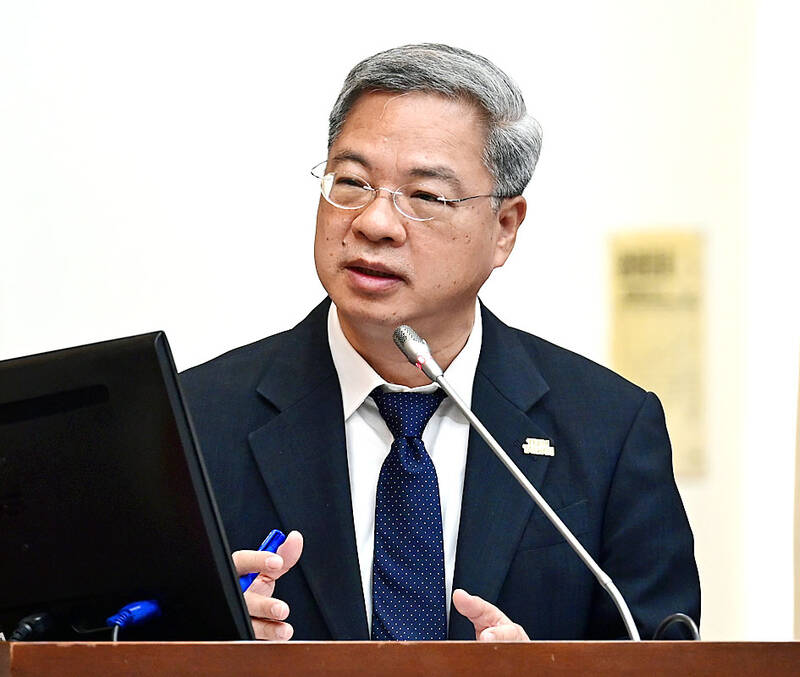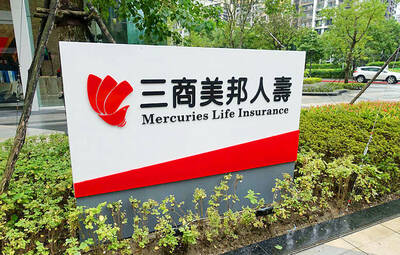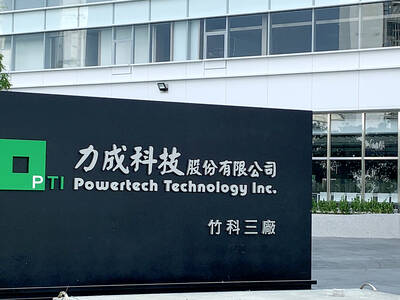There would be no 50-50 split in chip production between Taiwan and the US, Minister of Economic Affairs Kung Ming-hsin (龔明鑫) said yesterday ahead of a legislative meeting in Taipei, responding to comments by officials in Washington.
US Secretary of Commerce Howard Lutnick late last month proposed a “50-50 split” in semiconductor manufacturing, with half of chips used in the US to be made domestically, a plan that Vice Premier Cheng Li-chiun (鄭麗君), who is leading tariff talks with Washington, last week said would not happen.
Taiwan Semiconductor Manufacturing Co (TSMC, 台積電) is investing US$165 billion in six advanced wafer fabs in the US, but building 10 in Taiwan, with more planned, making a 50-50 production split impossible, Kung said.

Photo: Wang Yi-sung, Taipei Times
The outcome of Taiwan-US trade negotiations would be better than a 50-50 split deal, he added.
While the US government might have semiconductor development expectations, TSMC remains in the lead in US investments, where it holds sole ownership, Kung said.
Although TSMC also has investments in Japan and Germany, the company’s most advanced process technologies and the bulk of its production would remain in Taiwan, he said.
“Taiwan’s fabs would still be the most profitable,” he added.
Regarding TSMC and other overseas investments of semiconductor companies, Kung said that the government’s attitude is that if there are orders and profits overseas, no concerns about national security and it benefits the industry, then the government would provide administrative assistance.
The government could provide support such as living and transportation assistance if companies form industrial clusters overseas, while in places like Japan, the government would also help negotiate tax breaks or other benefits with local authorities, he said.
As for investment at home, companies have pledged nearly NT$3 trillion (US$98.25 billion) in combined investment in the government’s three major “Invest in Taiwan” programs and the figure is expected to rise, Kung said.
The Executive Yuan in July approved an extension of the programs to 2027, while boosting the loan limit to NT$720 billion from NT$360 billion.

Mercuries Life Insurance Co (三商美邦人壽) shares surged to a seven-month high this week after local media reported that E.Sun Financial Holding Co (玉山金控) had outbid CTBC Financial Holding Co (中信金控) in the financially strained insurer’s ongoing sale process. Shares of the mid-sized life insurer climbed 5.8 percent this week to NT$6.72, extending a nearly 18 percent rally over the past month, as investors bet on the likelihood of an impending takeover. The final round of bidding closed on Thursday, marking a critical step in the 32-year-old insurer’s search for a buyer after years of struggling to meet capital adequacy requirements. Local media reports

US sports leagues rushed to get in on the multi-billion US dollar bonanza of legalized betting, but the arrest of an National Basketball Association (NBA) coach and player in two sprawling US federal investigations show the potential cost of partnering with the gambling industry. Portland Trail Blazers coach Chauncey Billups, a former Detroit Pistons star and an NBA Hall of Famer, was arrested for his alleged role in rigged illegal poker games that prosecutors say were tied to Mafia crime families. Miami Heat guard Terry Rozier was charged with manipulating his play for the benefit of bettors and former NBA player and

The DBS Foundation yesterday announced the launch of two flagship programs, “Silver Motion” and “Happier Caregiver, Healthier Seniors,” in partnership with CCILU Ltd, Hondao Senior Citizens’ Welfare Foundation and the Garden of Hope Foundation to help Taiwan face the challenges of a rapidly aging population. The foundation said it would invest S$4.91 million (US$3.8 million) over three years to foster inclusion and resilience in an aging society. “Aging may bring challenges, but it also brings opportunities. With many Asian markets rapidly becoming super-aged, the DBS Foundation is working with a regional ecosystem of like-minded partners across the private, public and people sectors

BREAKTHROUGH TECH: Powertech expects its fan-out PLP system to become mainstream, saying it can offer three-times greater production throughput Chip packaging service provider Powertech Technology Inc (力成科技) plans to more than double its capital expenditures next year to more than NT$40 billion (US$1.31 billion) as demand for its new panel-level packaging (PLP) technology, primarily used in chips for artificial intelligence (AI) applications, has greatly exceeded what it can supply. A significant portion of the budget, about US$1 billion, would be earmarked for fan-out PLP technology, Powertech told investors yesterday. Its heavy investment in fan-out PLP technology over the past 10 years is expected to bear fruit in 2027 after the technology enters volume production, it said, adding that the tech would